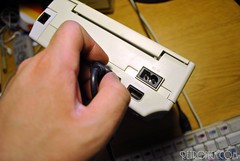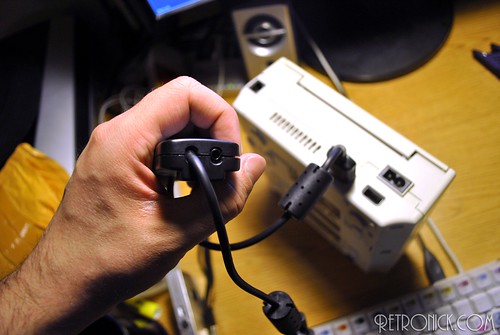As I have an unending curiosity with regard to new peripherals for vintage systems, I couldn't help but try out a Dreamcast VGA cable for myself. I was skeptical at first as I've played my Dreamcast through the same RCA cable since it's launch in 1999, and wasn't certain the extra boost from VGA would be worth the hassle of disconnecting and reconnecting my Dreamcast. God was I ever wrong... Observe.
 |
| I thought I knew you Sonic Adventure... |
Now before I get too into the examples, I think I need to explain the process used in gathering these images. Since I'm lacking the $300 device required to do true VGA screen grabs, the VGA examples were captured using a digital camera and tripod shooting the image on an HDTV. As such, you may notice some slight issues with color or distortion. This is pretty common with this capture method, and if you have a less-expensive workaround I'd love to hear it. The RCA examples were grabbed using a Canopus ADVC-110 and Premiere Pro. Though it's true this device also runs into the hundreds of dollars, it captures the RCA and S-Video I need it to. I never thought I'd need to capture from VGA for obvious reasons.
 |
| You could cut yourself on that hair. |
 |
| No stupid sub-menu to configure? This thing's practically ahead of the PS3. |
 |
| It seems so obvious now... |
What follows are a few more examples of the sharper image quality I received through using my Dreamcast with Racketboy's VGA cable.
 |
| Colors seemed much more vibrant. I just can't get over how sharp everything looks. |
Overall, I was very impressed with this particular VGA cable. Along with not eating up as much space in your entertainment center as a traditional VGA Box would, it's small form factor makes it tremendously easy to store when not in use. It's short length is also handy on a desktop, where your Dreamcast is going to be competing for prime real estate with your keyboad, mouse, tablet, etc... If you have a Dreamcast, and want to get the most out of it in the post SD world, then this is a definite buy. Even if you're comfortable still running on an old CRT TV, this thing is great to own if you're taking your Dreamcast to a friend's for some LAN-action, or want to fire up some Bomberman Online on their big-ol' HD screen.
The games I tested through the cable were:
Sonic Adventure
Sonic Adventure 2
Shenmue
Jet Grind Radio
Blue Stinger
Virtual On: Oratorio Tangram
Gunbird 2
Out of all the games tested, only Gunbird 2 gave me a compatibility error, which was easy to bypass using the old-school, VGA workaround method of unplugging the cable right before loading the game from the system menu. Despite not being compatible, it still looked pretty sharp, and I was finally able to utilize the Arcade viewing mode in that game by rotating my LCD monitor 90º.
Summing it up
+ Clearest, sharpest picture I've seen on Dreamcast games that wasn't emulated
+ 480P on an 11 year-old console
+ Easy to use
+ Good stereo audio at a consistent level
+ Small form-factor
- Some details that were meant to be smoothed out by interlacing become slightly aliased,
but not badly, and primarily in games that don't support the VGA capability natively
The games I tested through the cable were:
Sonic Adventure
Sonic Adventure 2
Shenmue
Jet Grind Radio
Blue Stinger
Virtual On: Oratorio Tangram
Gunbird 2
Out of all the games tested, only Gunbird 2 gave me a compatibility error, which was easy to bypass using the old-school, VGA workaround method of unplugging the cable right before loading the game from the system menu. Despite not being compatible, it still looked pretty sharp, and I was finally able to utilize the Arcade viewing mode in that game by rotating my LCD monitor 90º.
Summing it up
+ Clearest, sharpest picture I've seen on Dreamcast games that wasn't emulated
+ 480P on an 11 year-old console
+ Easy to use
+ Good stereo audio at a consistent level
+ Small form-factor
- Some details that were meant to be smoothed out by interlacing become slightly aliased,
but not badly, and primarily in games that don't support the VGA capability natively


Very cool -- and interesting! Sadly, I don't think my HDTV has VGA inputs. Still, this post has me hankering for some more Dreamcast action :)
ReplyDeleteThanks! I was pretty impressed with the look I got on my LCD monitor as well if you've got one of those kicking around. It's really nice to see an image that's close to what the developers must have seen when working on it.
ReplyDeleteOnly $20 by the looks of it as well. Way better than the Sega official equivalent, which is more around the $100 mark.
ReplyDelete@Brendan Yeah, I was pretty damned surprised with the results from such an inexpensive VGA adapter.
ReplyDeleteYou should try Alone in the Dark the New Nightmare on Dreamcast. It destroys the Ps2 version !
ReplyDelete@Jehad That sounds legit. The PS2 version of Dead or Alive 2 absolutely paled in comparison to the Dreamcast version as well. To be fair though, most early PS2 games were utterly hideous due to difficulty programming for that monster. That said, I've never been a fan of Sony consoles myself, and Alone in the Dark wasn't a super early PS2 game :D.
ReplyDelete@Retronick Yeah the early PS2 titles weren't that impressive. And yeah Alone in the Dark the New Nightmare came out about a year after the PS2 was released and sadly only in Europe.
ReplyDelete